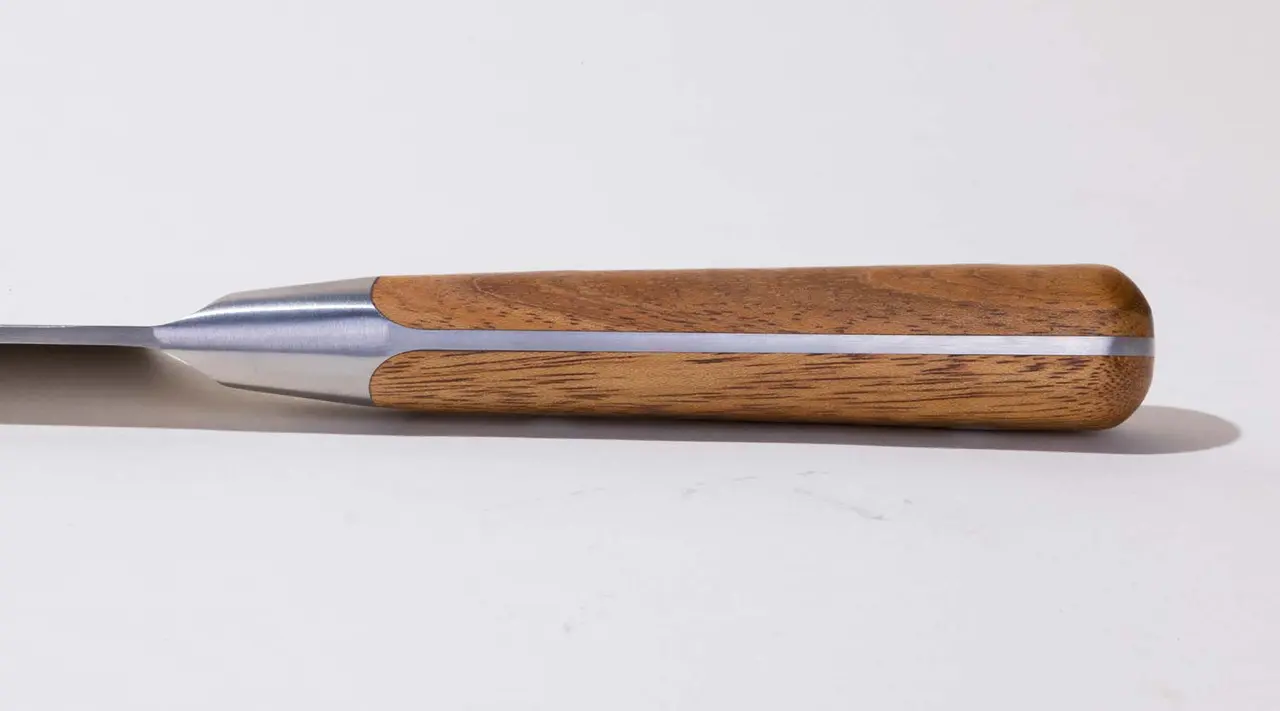If you’ve ever looked close-up at a high-quality chef knife, you may have noticed a thin stripe of metal running from the tip of the blade all the way through to the base of the handle, flanked by a line of rivets on either side. Rather than a design element, this strip indicates that your knife is made with full tang construction.
Aside from making your knife a bit cooler-looking, however, is there any actual benefit to a full tang blade? In short: absolutely. From performance to durability, here’s why full tang reigns supreme—and why it’s worth the investment.
What Does Full Tang Mean?

So what exactly is tang, and why does it matter so much when choosing a knife? Basically, the tang—usually hidden partially or completely by the handle material—is made from the same piece of metal that forms the blade. The wood or plastic portion on the outside is there to offer a better, more comfortable grip, but the tang is what keeps the knife stable and balanced.
Many full tang knives are fully forged, which means that the bladesmith starts with a single rod of metal, heating it until red hot and then pounding it flat. The metal then goes through a series of steps, such as tempering and quenching, to harden and strengthen the steel. The handle materials are attached with rivets, often in two long pieces—aka scales—that typically leave a thin sliver of metal exposed. The forging process combined with the full tang construction makes for a stronger and more balanced knife.
Full vs. Partial Tang
In a partial tang knife, the metal portion only extends partway through the handle, rather than all the way to the end. This results in a weak spot—typically where the blade meets the handle—that can be prone to breakage or snapping.
These knives are also often stamped, rather than fully forged, and aren’t usually as strong or balanced as a fully forged, full tang knife. You can read up on the differences between fully forged vs. stamped knives in our dedicated guide.
Advantages of Using Full Tang Knives

While often a bit pricier than partial tang knives, full tang knives are almost always going to be a better investment. Here’s how they measure up in terms of strength, balance, and durability.
Enhanced Balance and Comfort
Because of the metal extending all the way from the tip of the blade to the butt of the handle (read more about knife anatomy in our dedicated guide), a full tang knife is usually more balanced than a partial tang knife.
This is because typical knife handles are made from relatively lightweight materials such as plastic, rubber, or wood. In a partial tang knife, this makes for a blade-heavy knife that may feel unbalanced or unstable in the hand, and even lead to hand fatigue. Plus, many full tang knives have a bolster, which contributes to a balanced handfeel.
Longevity and Durability
Because a full tang knife is made from a single long piece of metal, it has fewer weak spots than a partial tang knife. Whereas a partial tang knife will probably break apart after a few years of wear and tear, a full tang knife will last decades (or longer) with proper care.
Full tang knives are typically the go-to for professional chefs, who need an exceptionally strong, durable blade that can stand up to hours of daily use. They’re also the best option for home cooks looking to invest in a single, long-lasting knife, instead of having to replace blades after only a handful of years.
Ready to Shop?
With our knife collection, fortunately, you’ll never have to settle for a less-than-stellar knife. All of our blades are full tang and fully forged by 5th generation bladesmiths in Thiers, France, so you can count on an excellent cutting experience every time—whether you’re breaking down a whole chicken, or just slicing up an orange for zero-proof Sbagliatos.
























